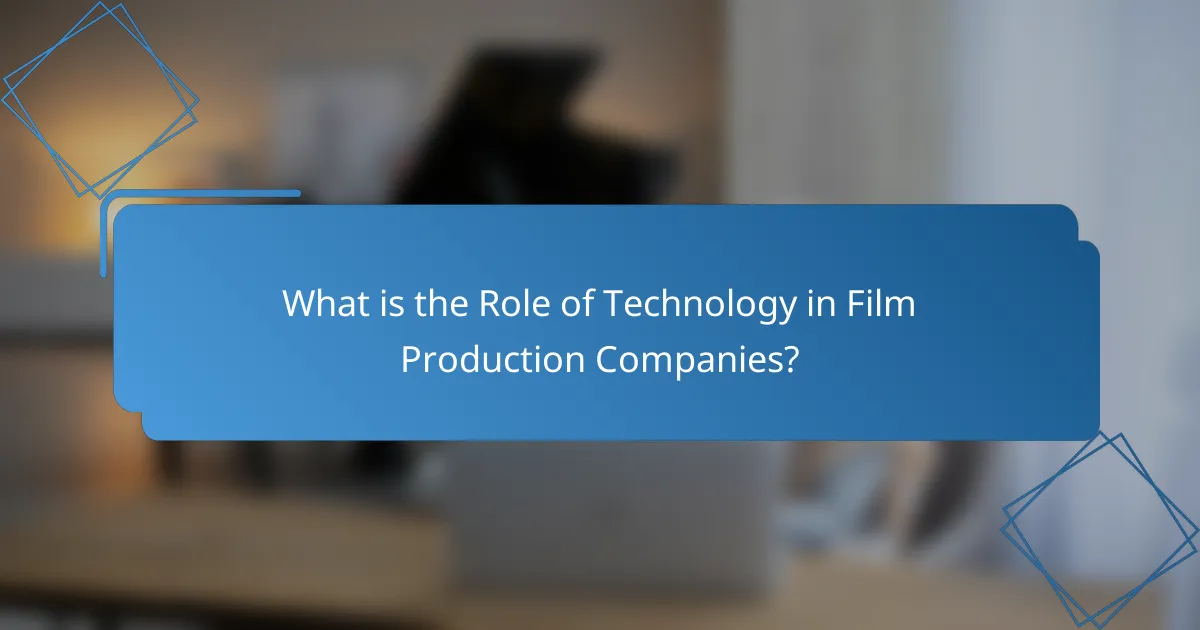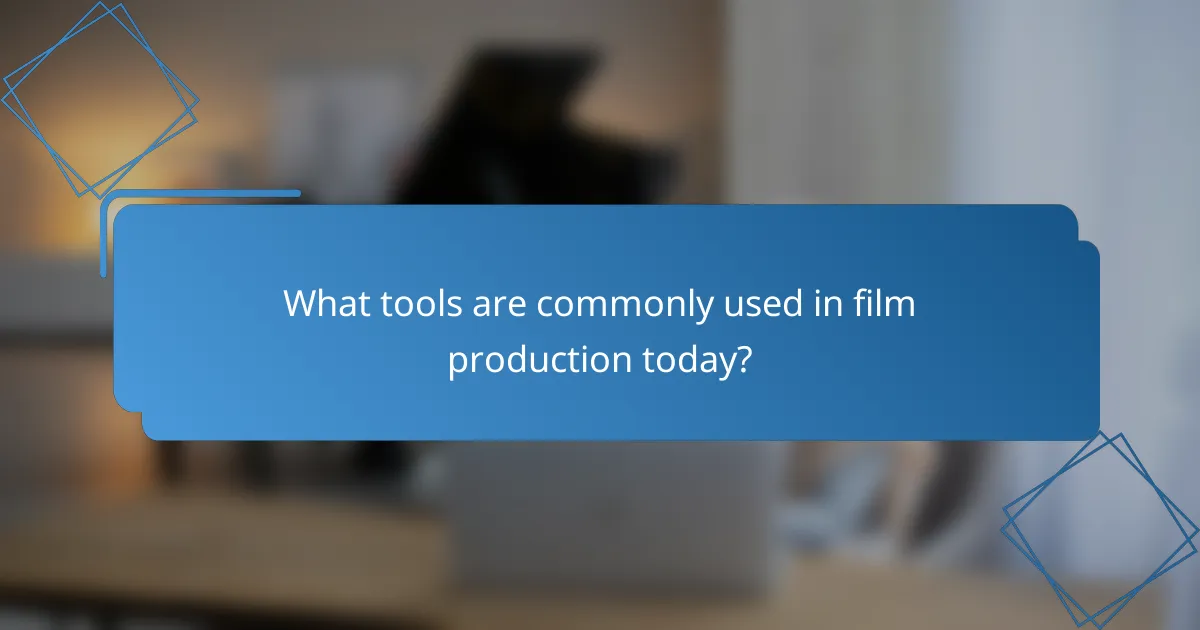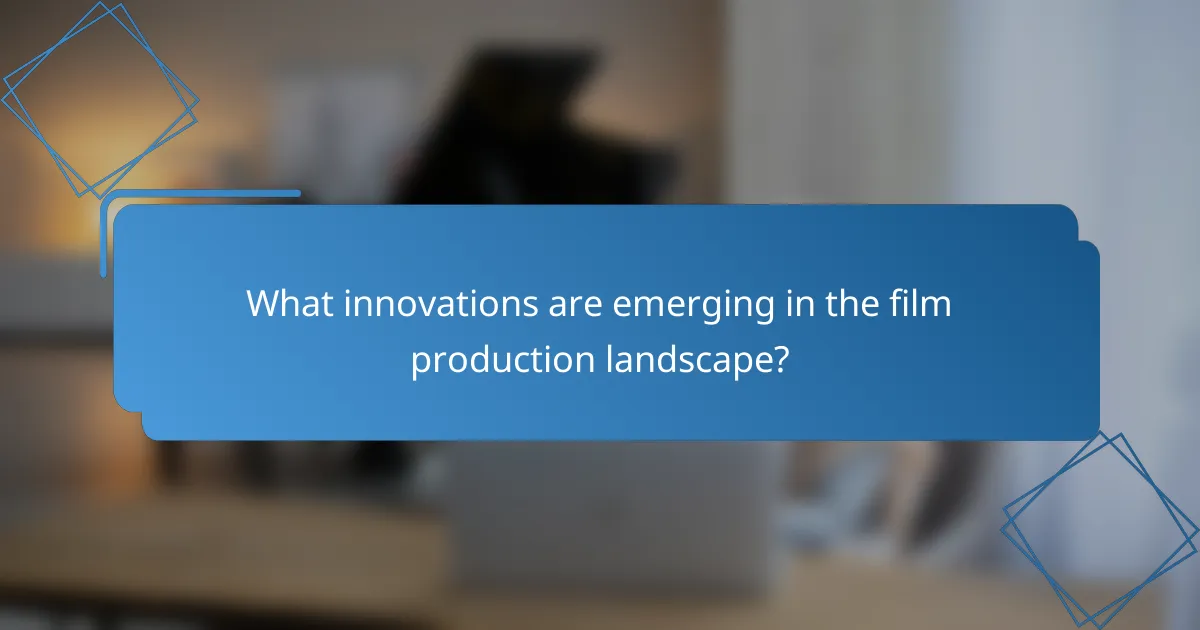Technology is a fundamental component in film production companies, significantly enhancing both efficiency and creativity across various stages, including pre-production, production, and post-production. Key advancements such as digital cameras, visual effects software, and collaboration tools have transformed traditional filmmaking practices, leading to higher quality footage and improved storytelling capabilities. The use of drones and 3D printing has further innovated filming techniques and set designs. Additionally, emerging technologies like virtual reality (VR), augmented reality (AR), and artificial intelligence (AI) are reshaping content creation and audience engagement. This article explores the tools and innovations that are defining the modern film production landscape.

What is the Role of Technology in Film Production Companies?
Technology plays a crucial role in film production companies by enhancing efficiency and creativity. It streamlines various processes such as pre-production, production, and post-production. Digital cameras have replaced traditional film, allowing for higher quality footage and easier editing. Software for visual effects and animation has transformed storytelling capabilities. Collaboration tools enable real-time communication among teams, regardless of location. Technologies like drones and 3D printing are revolutionizing filming techniques and set designs. According to a 2021 report by the Motion Picture Association, technology investment in production has increased by 30% over the last decade. This investment leads to more innovative films and improved audience experiences.
How has technology transformed the film production process?
Technology has significantly transformed the film production process through advancements in equipment and techniques. Digital cameras have replaced traditional film cameras, allowing for higher resolution and easier editing. This shift has reduced production costs and time.
Computer-generated imagery (CGI) has enabled filmmakers to create visual effects that were previously impossible. Editing software has streamlined post-production, making it more accessible to independent filmmakers.
Virtual reality and augmented reality technologies are enhancing storytelling by providing immersive experiences. Streaming platforms have changed distribution methods, allowing for broader audience reach.
According to a 2021 report by the Motion Picture Association, over 80% of films are now produced using digital technology. This indicates a significant industry shift towards technology-driven production processes.
What are the key technological advancements in film production?
Key technological advancements in film production include digital cinematography, CGI, and virtual reality. Digital cinematography replaces traditional film with digital sensors. This shift allows for instant playback and easier editing. CGI, or computer-generated imagery, enhances visual effects and creates immersive worlds. It has transformed storytelling by enabling scenes that were previously impossible. Virtual reality offers interactive experiences, allowing audiences to engage with narratives in new ways. Drones have revolutionized aerial shots, providing unique perspectives at lower costs. Additionally, advancements in sound technology, like Dolby Atmos, create immersive audio experiences. These innovations collectively enhance the film production process and viewer engagement.
How do these advancements enhance storytelling and creativity?
Advancements in technology enhance storytelling and creativity by providing filmmakers with innovative tools and techniques. These tools enable more immersive experiences through virtual reality and augmented reality. Filmmakers can create realistic visual effects that were previously impossible. High-definition cameras allow for greater detail and clarity in visuals. Advanced editing software streamlines the post-production process, enabling more creative freedom. Data analytics can inform storytelling choices based on audience preferences. Collaborative platforms facilitate teamwork among creators, enhancing the creative process. These technologies collectively push the boundaries of traditional storytelling methods.
Why is technology essential for modern film production companies?
Technology is essential for modern film production companies because it enhances efficiency and creativity. Advanced cameras and editing software allow for high-quality visuals and streamlined post-production. Innovations like CGI and motion capture expand storytelling possibilities. Technologies such as drones enable unique aerial shots, adding production value. Furthermore, digital distribution platforms facilitate wider audience reach. Industry statistics show that 85% of filmmakers use digital tools for production. This reliance on technology is crucial for staying competitive in the evolving film landscape.
What challenges do film production companies face without technology?
Film production companies face significant challenges without technology. They struggle with inefficient communication and collaboration among team members. Traditional methods can lead to delays and misunderstandings. Scheduling becomes difficult without digital tools to manage timelines. Resource allocation suffers as tracking becomes manual and prone to errors. Editing and post-production processes are slower without advanced software. Distribution of films is hampered as digital platforms are essential for reaching audiences. Overall, these challenges hinder productivity and creativity in the filmmaking process.
How does technology improve efficiency and reduce costs in film production?
Technology improves efficiency and reduces costs in film production through automation and advanced tools. Digital cameras and editing software streamline the filming and post-production processes. This reduces the need for extensive physical setups and lengthy editing sessions. Cloud-based collaboration tools enable real-time communication among teams, minimizing delays. Additionally, virtual production techniques allow for on-set adjustments, reducing reshoots. Moreover, data analytics helps in budgeting and resource allocation, ensuring optimal use of funds. According to a 2021 report by the Producers Guild of America, technology adoption has led to a 20% decrease in production costs for many projects. These advancements collectively enhance productivity while lowering expenses in the industry.

What tools are commonly used in film production today?
Cameras, lighting equipment, and editing software are commonly used in film production today. Digital cameras, such as the Sony A7 series and Canon EOS range, capture high-quality footage. Lighting tools, like LED panels and softboxes, enhance visual aesthetics. Editing software, including Adobe Premiere Pro and Final Cut Pro, facilitates post-production processes. Sound recording equipment, such as boom microphones and audio interfaces, ensures clear audio capture. Drones are increasingly utilized for aerial shots, adding unique perspectives. Production management tools, like StudioBinder, streamline scheduling and communication. These tools collectively enhance the efficiency and quality of film production.
What types of software are integral to film production?
Film production relies on various types of software. Pre-production software includes tools for scriptwriting and scheduling, like Final Draft and Movie Magic Scheduling. Production software encompasses camera and audio tools, such as Avid Media Composer and Adobe Premiere Pro. Post-production software is critical for editing and visual effects, with options like DaVinci Resolve and Adobe After Effects. Additionally, project management tools like Trello and Shotgun facilitate collaboration and workflow. Each software type serves a specific purpose, enhancing efficiency and creativity in the filmmaking process.
How do editing software and visual effects tools contribute to film quality?
Editing software and visual effects tools significantly enhance film quality. These tools enable precise control over visuals and audio. Editing software allows for seamless cuts and transitions, improving narrative flow. It also facilitates color correction, enhancing the overall aesthetic appeal. Visual effects tools create realistic environments and elements that enrich storytelling. They can simulate complex scenarios that would be difficult or impossible to film practically. High-quality visual effects contribute to audience immersion and engagement. Studies show that films with advanced editing and visual effects often receive higher critical acclaim and box office success.
What role does project management software play in production planning?
Project management software facilitates production planning by streamlining project workflows. It enables teams to organize tasks, allocate resources, and set deadlines efficiently. This software offers real-time collaboration features, allowing team members to communicate effectively. It also provides tools for tracking progress and managing budgets, ensuring projects stay on schedule and within financial constraints. According to a study by the Project Management Institute, organizations that use project management software report a 20% increase in productivity. This demonstrates the software’s effectiveness in enhancing production planning processes.
What hardware innovations are shaping the film industry?
Hardware innovations shaping the film industry include advanced cameras, drones, and virtual reality equipment. High-resolution digital cameras, such as the RED Komodo, allow filmmakers to capture stunning visuals with greater detail. Drones enable aerial cinematography, providing unique perspectives and reducing production costs. Virtual reality headsets, like the Oculus Quest, facilitate immersive storytelling experiences. Additionally, motion capture technology, exemplified by systems like Vicon, enhances character animation and realism. These innovations collectively improve production quality and efficiency, transforming how films are made and experienced.
How have cameras evolved in the digital age?
Cameras have evolved significantly in the digital age. The transition from film to digital technology has transformed photography and videography. Digital cameras offer instant image review, eliminating the need for film development. They feature higher resolution sensors, allowing for greater detail and clarity in images. Many digital cameras now include advanced features like autofocus, image stabilization, and connectivity options. The rise of mirrorless cameras has further reduced size and weight while maintaining high performance. Additionally, smartphone cameras have democratized photography, making it accessible to a broader audience. These advancements have greatly influenced the film production industry, enhancing creativity and efficiency.
What impact do drones and advanced lighting systems have on filming techniques?
Drones and advanced lighting systems significantly enhance filming techniques. Drones enable aerial shots that were previously difficult or impossible to achieve. They provide unique perspectives and dynamic movement, improving storytelling. Advanced lighting systems allow for precise control over illumination. This results in better image quality and mood setting. The combination of these technologies increases production value. Studies show that films utilizing drones often receive higher audience engagement. Moreover, advanced lighting techniques can reduce post-production time by achieving desired effects on set.

What innovations are emerging in the film production landscape?
Emerging innovations in the film production landscape include virtual reality (VR) and augmented reality (AR) technologies. These tools enhance storytelling by creating immersive experiences for viewers. Additionally, artificial intelligence (AI) is being used for script analysis and post-production processes. AI can predict audience preferences, allowing for more tailored content creation. Drones are revolutionizing cinematography by providing unique aerial shots at lower costs. Furthermore, cloud-based collaboration tools streamline workflows for remote teams. These innovations are reshaping how films are produced, making the process more efficient and creative.
How is virtual reality (VR) influencing film production?
Virtual reality (VR) is significantly influencing film production by enhancing storytelling and viewer engagement. VR allows filmmakers to create immersive experiences that transport audiences into the narrative. This technology enables the use of 360-degree videos and interactive environments. Filmmakers can experiment with new forms of narrative structure through VR.
According to a report by PwC, the global VR market in entertainment, including film, is expected to grow to $8 billion by 2024. This growth indicates a rising trend in the adoption of VR in film. Additionally, studios like Warner Bros. have embraced VR for promotional content and immersive experiences related to their films.
The integration of VR in film production is reshaping how stories are told and experienced. It opens new avenues for creativity and audience interaction, making it a transformative force in the industry.
What are the potential applications of VR in storytelling?
Virtual Reality (VR) in storytelling offers immersive experiences that engage audiences in unique ways. It allows users to step into narratives, experiencing stories from a first-person perspective. This technology enhances emotional connections by placing viewers directly within the story world. VR can be used for interactive storytelling, where choices affect the narrative outcome. It also enables spatial storytelling, allowing for exploration of environments that traditional media cannot provide. Projects like “The Invisible Man” VR experience demonstrate how VR can expand cinematic storytelling. According to a study by the University of Southern California, VR significantly increases user engagement and emotional involvement in narratives.
How does VR change audience engagement with films?
VR enhances audience engagement with films by creating immersive experiences. This technology allows viewers to feel present within the film’s environment. Audiences can explore scenes from multiple angles. They can interact with characters and objects in real-time. This level of interactivity fosters a deeper emotional connection to the story. Studies show that VR experiences can increase retention of plot details by up to 40%. Additionally, VR can transform passive viewing into active participation. This shift in engagement leads to more personalized storytelling experiences. Overall, VR redefines how audiences connect with film narratives.
What role does artificial intelligence (AI) play in film production?
Artificial intelligence (AI) plays a significant role in film production. AI is utilized for script analysis, helping writers identify trends and improve storytelling. AI algorithms can predict audience preferences based on data analysis. This leads to more targeted marketing strategies and better box office performance. Additionally, AI enhances visual effects through automated processes, reducing production time. AI tools assist in casting by analyzing actor performances and audience reception. Furthermore, AI is used for video editing, streamlining the post-production phase. According to a 2020 report by PwC, AI can increase efficiency in film production by up to 30%.
How can AI assist in scriptwriting and pre-production planning?
AI can assist in scriptwriting and pre-production planning by automating various tasks. It can generate script ideas based on prompts. AI tools analyze existing scripts to identify trends and successful elements. This analysis helps writers craft compelling narratives. AI can also assist in character development by suggesting traits and arcs. Additionally, it can streamline scheduling and budgeting in pre-production. AI tools can predict potential production challenges based on historical data. These capabilities enhance efficiency and creativity in the filmmaking process.
What are the ethical considerations of using AI in filmmaking?
Ethical considerations of using AI in filmmaking include issues of authorship, bias, and transparency. AI can generate content that raises questions about who owns the created work. When AI is trained on existing films, it may inadvertently replicate biases present in the source material. This could lead to the perpetuation of stereotypes or exclusion of diverse voices. Transparency in AI processes is crucial for accountability. Filmmakers must disclose when AI is used in production to maintain trust with audiences. Additionally, the potential for job displacement in the industry poses ethical concerns. As AI tools become more prevalent, they may replace certain roles traditionally held by human creatives. These considerations highlight the need for ethical frameworks in the integration of AI in filmmaking.
What are the best practices for integrating technology in film production?
Best practices for integrating technology in film production include adopting digital pre-production tools. These tools streamline scheduling and budgeting processes. Utilizing cloud-based platforms enhances collaboration among team members. Implementing virtual production techniques allows for real-time visual effects. Employing high-quality cameras and drones improves cinematography. Integrating editing software early in the process facilitates smoother post-production. Utilizing data analytics helps in audience targeting and marketing strategies. Continuous training for crew members ensures they remain updated on new technologies.
How can production companies stay updated with technological trends?
Production companies can stay updated with technological trends by actively engaging in industry research and networking. They should subscribe to industry publications and attend relevant conferences. These activities provide insights into emerging technologies and best practices. Collaborating with technology vendors can also help production companies access the latest tools. Additionally, companies can participate in workshops and training sessions. This hands-on experience enhances their understanding of new technologies. Regularly reviewing case studies from successful projects can further inform their strategies. By implementing these practices, production companies can remain competitive in a rapidly evolving landscape.
What strategies can filmmakers use to effectively utilize new tools?
Filmmakers can effectively utilize new tools by incorporating them into their production processes. They should start by researching the latest technologies relevant to their projects. This includes understanding software for editing, sound design, and visual effects. Training team members on these tools enhances overall competency. Filmmakers should also consider collaboration with tech experts to optimize tool usage. Experimenting with new tools during pre-production can lead to innovative storytelling techniques. Regularly attending workshops and industry conferences keeps filmmakers updated on advancements. Finally, gathering feedback from audiences on the effectiveness of new tools can inform future projects.
The main entity of the article is technology in film production companies. The article explores the critical role technology plays in enhancing efficiency and creativity within the film industry, detailing advancements such as digital cinematography, CGI, and virtual reality. It highlights the impact of various tools and software on production processes, including project management and editing systems, while discussing the challenges faced by companies that do not adopt these technologies. Additionally, it addresses emerging innovations like artificial intelligence and drones, emphasizing their influence on storytelling and audience engagement.